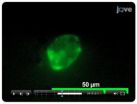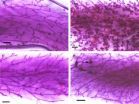(Press-News.org) TORONTO, ON—Scientists at the University of Toronto have found a molecular mechanism that plays a key role in the transition of Candida albicans yeast into disease-causing fungus—one of the leading causes of hospital-acquired infection. The finding highlights the importance of heat in fungal growth, and provides a new target for drug therapies to counter Candida albicans infection.
Candida albicans is a normally harmless yeast that is present in all humans. It becomes infectious in various genetic and environmental conditions, with temperature as a key determinant. It can produce infections that are mild—persistent vaginal or gut infections, for example—or severe, such as systemic, potentially fatal bloodstream infections in patients with AIDS or those who have undergone chemotherapy (or even a simple round of antibiotics).
The molecular workings of Candida albicans were mapped for the first time in 2009 by Professor Leah Cowen of the University of Toronto's Department of Molecular Genetics, whose lab showed that growth of the fungus is tied to the function of a "molecular chaperone" called heat-shock protein 90 (Hsp90). In a study that will appear in the March 20 edition of the journal Current Biology, Prof. Cowen and her colleagues detail a mechanism that controls response to elevated temperature through a protein named Hms1 in conjunction with a cyclin (another type of protein) and its partner protein called a cyclin-dependent kinase.
"This circuitry fundamentally influences how Candida albicans senses temperature, which is crucial for Candida's ability to cause disease," said Prof. Cowen, who holds the Canada Research Chair in Microbial Genomics and Infectious Disease—a prestigious five-year award for which she was renewed this week.
"We were looking for a transcription factor at the end of a pathway we previously showed was key to the change in shape of the fungus that accompanies elevated temperature or compromise of Hsp90 function, and instead we found an entirely new pathway, with components that haven't been characterized in Candida, so it was very surprising," said Prof. Cowen.
The researchers also showed that deletion of Hms1 inhibits Candida albicans infection, pointing toward a possible clinical therapy. "We observed those weaker disease phenotypes in an insect model system, but the results suggest it may also work in more complicated systems," said Prof. Cowen.
The source of pesky vaginal and gut infections, Candida albicans is a burgeoning problem on implanted medical devices—it's fatal in roughly one-third of device-associated infections—and is the fourth-leading cause of hospital-acquired infection. The number of acquired fungal bloodstream infections has increased by more than 200% over the last twenty years, owing in part to growing numbers of AIDS and cancer survivors whose treatments have compromised their immune function.
On finding that the Hms1 pathway affects the growth and development of Candida albicans, and knowing of other key regulators through which Hsp90 operates and suspecting many more exist, Prof. Cowen and her lab examined other pathways and proteins that interact with Hsp90 in another study.
In collaboration with Professor Gary Bader at U of T's Donnelly Centre for Cellular and Biomolecular Research, Prof. Cowen's group mapped a much larger portion of the chaperone network with which Hsp90 interacts through a "chemical genomics" approach that had never been applied to Candida albicans. "If we want to have a more global understanding of what Hsp90 is doing during the transition of this fungus between distinct morphological states with different disease causing properties, we need to take global approaches to determine what its interacting with," said Prof. Cowen.
Their results, published online today in the journal PLoS Genetics, showed 226 genetic interactors with Hsp90 in various conditions, such as different temperatures and during exposure to anti-fungal drugs. Of those interactions, 224 were previously unknown. "That's a lot," said Prof. Cowen. "We now have a myriad of new targets through which Hsp90 could be regulating morphogenesis and drug resistance in Candida."
As well, the researchers drew several predictive rules from their study that govern the Hsp90 chaperone network. Some interactors were only important in a small subset of stress conditions, and these are likely to function "downstream" of Hsp90 regulating specialized cellular processes. Other interactors were important in many stress conditions, and so are likely to work "upstream" of Hsp90 regulating its function.
"Hsp90 stabilizes many proteins, but previously nobody could predict what made an Hsp90 client. That we can make such predictions from the chaperone network is pretty cool and unanticipated, so we're further ahead than we expected," said Prof. Cowen.
###
This research was supported by the Canadian Institutes of Health Research, the Natural Sciences and Engineering Research Council of Canada, the Fonds Québécois de la Recherche sur la Nature et les Technologies, the Burroughs Wellcome Fund, the Ontario Post-Doctoral Fellowship Program and the Canada Research Chairs Program.
Researchers uncover molecular pathway through which common yeast becomes fungal pathogen
Additional study identifies 224 new genetic interactors for key protein in Candida albicans
2012-03-19
ELSE PRESS RELEASES FROM THIS DATE:
Increase in Arctic shipping poses risk to marine mammals
2012-03-19
NEW YORK (March 16, 2012)—A rapid increase in shipping in the formerly ice-choked waterways of the Arctic poses a significant increase in risk to the region's marine mammals and the local communities that rely on them for food security and cultural identity, according to an Alaska Native groups and the Wildlife Conservation Society who convened at a recent workshop.
The workshop—which ran from March 12-14—examined the potential impacts to the region's wildlife and highlighted priorities for future management of shipping in the region. The meeting included participants ...
Glacier-fed river systems threatened by climate change
2012-03-19
Glacial meltwater increases biodiversity in mountainous freshwater ecosystems. As glaciers vanish due to global warming, so will those species dependent upon the icy runoff. This is the conclusion of a study authored by researchers from, among other institutions, the University of Copenhagen.
The article "Glacial river biodiversity" with the alarming new findings can be found in the journal Nature Climate Change.
"The knowledge is new and startling. Glacial runoff is cold, nutrient-poor and physically unstable, and therefore, typically species-poor. Traditionally, we ...
Researchers print live cells with a standard inkjet printer
2012-03-19
Researchers from Clemson University have found a way to create temporary holes in the membranes of live cells using a standard inkjet printer. The method will be published in JoVE, the Journal of Visualized Experiments, on March 16.
"We first had the idea for this method when we wanted to be able to visualize changes in the cytoskeleton arrangement due to applied forces on cells," said paper-author Dr. Delphine Dean.
She said other researchers have been using this method to print cells onto slides, but that they have only recently discovered that printing the cells ...
Study determines critical skills for PCPs to safely manage opioid risk in chronic pain patients
2012-03-19
The study's objective was to identify which skills and competencies are considered most critical for primary care providers (PCPs) to learn in order to effectively manage opioid risk in patients treated for chronic pain
Study participants included experts in primary care, pain management, and addiction
Experts in this study identified the most important skills for PCPs managing opioid risk in chronic pain patients as how to monitor opioids and how to assess for risk factors
Primary care physicians are faced with treating a large proportion of chronic pain patients, ...
Building the European Union's Natura 2000 -- the largest ever network of protected areas
2012-03-19
The European Union's Habitats Directive is now 20 years old, and its network of protected areas, known as Natura 2000, is nearing completion. After a slow start, the network now includes some 26 000 protected sites and covers approximately 18% of the EU's land surface as well as significant areas of sea. It is widely considered to be the world's largest network of protected areas based on agreed site selection criteria. The review has been published in the newly launched open-access journal Nature Conservation.
Douglas Evans, seconded to the Paris-based European Topic ...
Highly exposed to phthalates as fetuses, female mice have altered reproductive lives
2012-03-19
PROVIDENCE, R.I. [Brown University] — Female mouse fetuses exposed to very high doses of a common industrial chemical that makes plastics more pliable develop significant reproductive alterations and precancerous lesions as they grow up, according to a new toxicology study conducted at Brown University.
The administered doses of MEHP, the chemical that results when animals metabolize the industrial phthalate DEHP, were much higher than any normal environmental exposure that people or animals would encounter, said Mary Hixon, assistant professor of pathology and laboratory ...
Sharing patents with competitors may encourage innovation, UB study suggests
2012-03-19
BUFFALO, N.Y. -- Firms that make a previously patented innovation accessible to competitors increase overall likelihood of improving upon that breakthrough while also raising profits for the original innovator and market welfare, according to a study by a University at Buffalo economist.
The practice of free-licensing -- giving up patent protection -- corresponds to an evolutionary step in the study of patents and their effect on innovation, says the study's author Gilad Sorek, assistant visiting professor of economics at UB.
"This research arose from the notion that ...
Response rate high for some patients with metastatic melanoma treated with vemurafenib
2012-03-19
TAMPA, Fla. (March 16, 2012) – An international team of researchers from the United States and Australia, including researchers at Moffitt Cancer Center in Tampa, Fla., have found that the oral BRAF inhibitor vemurafenib (PLX4032) when tested in a phase II clinical trial offered a high rate of response in patients with previously treated metastatic melanoma and who had the BRAF mutation. More than 50 percent of the patients in the trial had positive, prolonged responses and a median survival of almost 16 months.
The study was published in a recent issue of the New England ...
Nanopills release drugs directly from the inside of cells
2012-03-19
UAB researchers developed a new vehicle to release proteins with therapeutic effects. The vehicles are known as "bacteria inclusion bodies", stable insoluble nanoparticles which are found normally in recombinant bacteria. Even though these inclusion bodies traditionally have been an obstacle in the industrial production of soluble enzymes and biodrugs, they were recently recognised to have large amounts of functional proteins with direct values in industrial and biomedical applications.
The research team led by Antoni Villaverde from the Institute of Biotechnology and ...
AGU journal highlights March 16, 2012
2012-03-19
The following highlights summarize research papers that have been recently
published in Geophysical Research Letters (GRL), Journal of Geophysical
Research-Atmospheres (JGR-D), and Journal of Geophysical Research-Solid
Earth (JGR-B).
In this release:
Measuring mercury in coastal fog water
Early Eocene climate warming increased petroleum production
Unexpected earthquakes within continental plates pose challenges
Land use changes contribute to climate extremes
When will warming-induced rainfall changes be perceptible?
Model describes New Zealand's complex tectonic ...
LAST 30 PRESS RELEASES:
New software sheds light on cancer’s hidden genetic networks
UT Health San Antonio awarded $3 million in CPRIT grants to bolster cancer research and prevention efforts in South Texas
Third symposium spotlights global challenge of new contaminants in China’s fight against pollution
From straw to soil harmony: International team reveals how biochar supercharges carbon-smart farming
Myeloma: How AI is redrawing the map of cancer care
Manhattan E. Charurat, Ph.D., MHS invested as the Homer and Martha Gudelsky Distinguished Professor in Medicine at the University of Maryland School of Medicine
Insilico Medicine’s Pharma.AI Q4 Winter Launch Recap: Revolutionizing drug discovery with cutting-edge AI innovations, accelerating the path to pharmaceutical superintelligence
Nanoplastics have diet-dependent impacts on digestive system health
Brain neuron death occurs throughout life and increases with age, a natural human protein drug may halt neuron death in Alzheimer’s disease
SPIE and CLP announce the recipients of the 2025 Advanced Photonics Young Innovator Award
Lessons from the Caldor Fire’s Christmas Valley ‘Miracle’
Ant societies rose by trading individual protection for collective power
Research reveals how ancient viral DNA shapes early embryonic development
A molecular gatekeeper that controls protein synthesis
New ‘cloaking device’ concept to shield sensitive tech from magnetic fields
Researchers show impact of mountain building and climate change on alpine biodiversity
Study models the transition from Neanderthals to modern humans in Europe
University of Phoenix College of Doctoral Studies releases white paper on AI-driven skilling to reduce burnout and restore worker autonomy
AIs fail at the game of visual “telephone”
The levers for a sustainable food system
Potential changes in US homelessness by ending federal support for housing first programs
Vulnerability of large language models to prompt injection when providing medical advice
Researchers develop new system for high-energy-density, long-life, multi-electron transfer bromine-based flow batteries
Ending federal support for housing first programs could increase U.S. homelessness by 5% in one year, new JAMA study finds
New research uncovers molecular ‘safety switch’ shielding cancers from immune attack
Bacteria resisting viral infection can still sink carbon to ocean floor
Younger biological age may increase depression risk in older women during COVID-19
Bharat Innovates 2026 National Basecamp Showcases India’s Most Promising Deep-Tech Ventures
Here’s what determines whether your income level rises or falls
SCIE indexation achievement: Celebrate with Space: Science & Technology
[Press-News.org] Researchers uncover molecular pathway through which common yeast becomes fungal pathogenAdditional study identifies 224 new genetic interactors for key protein in Candida albicans



